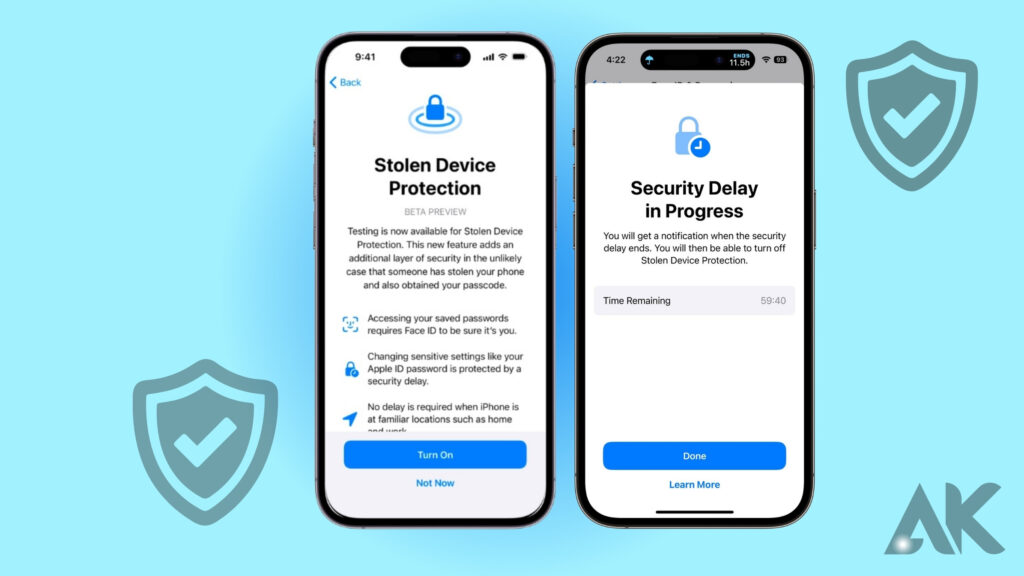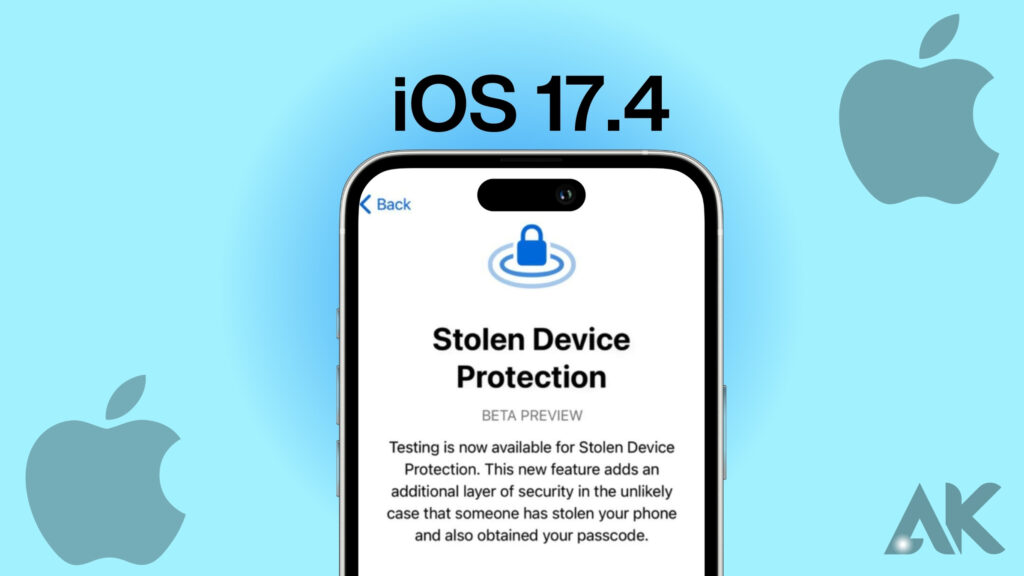iOS 17.4 brings a variety of security improvements, demonstrating once again how seriously Apple takes user data protection and device integrity. The most recent patch concentrates on fixing known security flaws, strengthening defences against new threats, and improving the operating system’s overall security architecture.
Take that, iPhone thieves! iOS 17.4 improves stolen device protection.

Just over a week has passed since iOS 17.3 introduced Stolen Device Protection, but there have been rumours that iOS 17.4 will include even more enhancements to the new security feature.
If a thief gets their hands on your iPhone passcode, stolen device protection will be your final line of defence. To access protected features on your iPhone, such as accessing passcodes, wiping content, disabling Lost Mode, and more, you’ll need to enable Face ID or Touch ID authentication. Stolen Device Protection necessitates two biometric authentications, with the second occurring one hour after the first, for particularly sensitive operations such as altering your Apple ID password or deactivating Find My iPhone.
When you conducted a sensitive action at a “familiar location,” like your home or workplace, only one instance of biometric authentication was necessary in the past—or, more accurately, is required now. Nonetheless, 9to5Mac reports that in iOS 17.4, you’ll always have the option to enable two-step authentication, no matter where you are.
Simply put, shortly, you will have the option to lock your iPhone into a single security mode. This will make it more difficult for a burglar to gain access to your device by getting it from a “familiar location.” You can still choose to simplify things by eliminating one of the steps described before if that’s more to your liking.
It should be noted that stolen device protection isn’t activated by default. If you haven’t activated the new feature on your iPhone yet, see our article on how to set it up. Will iOS 16 not let you go? Additionally, we provide instructions on how to get iOS 17.
We understand that third-party app stores and real third-party browsers will soon be available on iPhones with iOS 17.4. At the moment, third-party browsers are essentially just rebranded copies of Safari. Due to new rules in the EU, these changes are scheduled to be included in iOS 17.4 for the European areas.
Reportedly, game streaming services such as Xbox Cloud Gaming and GeForce Now will also be able to operate as standalone apps on a global scale with iOS 17.4. With iOS 17.4, the top iPhones should become even better gaming phones, eliminating the need to use a browser on an iPhone.
We anticipate that iOS 17.4, set to release in early March, will include some improvements, including podcast transcripts, new emojis, and additional language choices for Siri.
In iOS 17.4, Apple allows constant stolen device protection.

You can now use Face ID or Touch ID to verify your identity when you’re not in a familiar location (like home or the office) and want to do things like apply for a new Apple Card, erase all content and settings, take certain actions in Wallet with Apple Cash and Savings, use payment methods saved in Safari, or set up a new device on your iPhone. So many more things are possible now that you have the feature enabled.
However, the true safeguarding mechanism is activated at this point. Apple requires a one-hour delay before granting access to perform certain sensitive tasks that an intruder would need to access your iPhone, such as changing your Apple ID password, changing your iPhone passcode, adding or removing Face ID or Touch ID, disabling Find Me, or disabling Stolen Device Protection. Your identification still needs to be verified using Face ID or Touch ID, even after the hour has passed. If an iPhone is stolen, the victim has one hour to notice it’s gone and contact Apple to report the crime.
Conclusion
iOS 17.4 introduces robust security upgrades for iPhone users, focusing on enhancing the operating system’s security architecture, addressing potential vulnerabilities, and bolstering defences against emerging threats. Stolen Device Protection, a new feature, now requires Face ID or Touch ID authentication for sensitive actions like viewing passkeys, erasing content, and turning off Lost Mode. The update also allows two-step authentication for sensitive actions, reducing the risk of a thief breaking into an iPhone at a familiar location. Other features include third-party app stores, true third-party browsers, and support for game streaming services like Xbox Cloud Gaming and GeForce Now.
FAQS
What is stolen device protection?
Stolen Device Protection remembers a user’s “familiar locations,” like their house or office, and adds additional biometric security hurdles to overcome if someone attempts to access specific functions while the device is not in those locations.
Should I turn on stolen device protection?
Stolen Device Protection is a new feature in Apple’s iOS operating system that was released this week. It significantly increases the difficulty for phone thieves to access critical services and settings. It is strongly recommended that users activate it right away.

